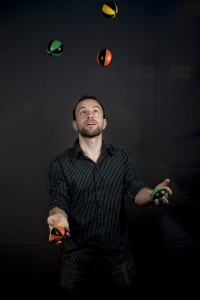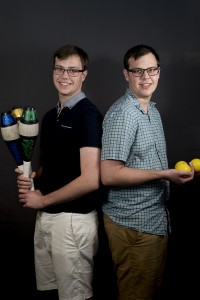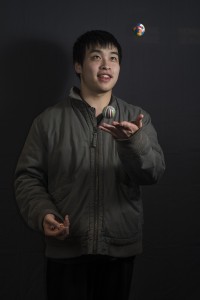White, red and yellow colors soared through the air next to Janss Steps when Michael Lefkowitz watched Claude Overdo juggle her clubs.
The sunny winter day was the start of a collaboration between the two performers.
Linguistics doctoral student Lefkowitz and alumna Overdo founded Juggling Club at UCLA in 2011. Every Tuesday, members of the club spend hours throwing, catching and passing balls and clubs next to Janss Steps.
With 233 members in the club’s Facebook group, Lefkowitz and other members organize times for jugglers to learn new tricks from each other and share a common love of juggling.
“It turns out that a lot of people know how to juggle,” Lefkowitz said. “They don’t tell you, but probably a lot of your friends learned how to juggle three balls in high school or gym class. We’re an invisible minority.”
First-year electrical engineering students Andrew Wilhelm and Aaron Wilhelm knew that they wanted to be in a juggling club in college. After joining the club during their first quarter at UCLA, they have taught around six students how to juggle, Aaron Wilhelm said.
[Related: Bruin shares experience learning ropes of circus performance]
In addition to juggling equipment, students can bring circus gear such as clubs, yo-yo’s, diablos and slacklines, Lefkowitz said.
The Wilhelm twins taught themselves how to use the diablo, a yo-yo-like contraption containing a blue ball and pink strings, by going to meetings and getting instruction from other members. With no circus classes currently on campus, the club is the only way for students to learn and improve their juggling abilities.
“There’s this misconception that jugglers are independent, antisocial people, and that’s not necessarily true,” Andrew Wilhelm said. “There are always people on the fringe who do stuff individually, but quite honestly it’s much easier when you have a group of people.”
Bringing Summer Camp to a College Campus
Although his father began teaching him basic juggling at age 12, Lefkowitz honed his skills, becoming more advanced and established when he attended Independent Lake Camp in his teenage years.
The camp introduced Lefkowitz to several circus acts, such as the flying trapeze and the unicycle. The camp impacted him so much as a teenager that he tried to build his own flying trapeze in his backyard with metal bars, rope and duct tape, Lefkowitz said.

Lefkowitz practices several circus abilities that go beyond beginner juggling – his closet consists of flaming knives, a flying trapeze, a fire ploy, torches and a fire-breathing apparatus. Even though he has many circus skills, he focuses on juggling at UCLA since the equipment is portable and doesn’t pose a safety hazard.
Although Lefkowitz has performed at kids’ birthday parties, he doesn’t see himself as a performer and prefers to juggle as a hobby, he said. The club gives him, along with the rest of the members, a place to practice his passion while maintaining an academic life.
[Related: UCLA alumnus mixes technology and spectacle]
Lefkowitz has served as the co-founder and leader of the Juggling Club at UCLA for six years. Within the six years, he has taught at least 200 newcomers how to juggle at their first club meetings.
“Part of the community of jugglers and circus arts people is this teaching spirit,” Lefkowitz said.
Although all experience levels are welcomed, members are challenged by learning new juggling tricks with the group. Lefkowitz and other members incorporate complex passing patterns that consist of five or more people simultaneously tossing clubs, resulting in a whirlwind of movement. While some students have performance backgrounds, the club aims to gather beginner and advanced jugglers in a casual, fun setting.
Lefkowitz and other members have passed clubs through the air from tree to tree; the clubs’ bright blue, white and green colors stand out while the jugglers sit on opposite tree branches.
“Every year or two I pick up some things totally different that I haven’t done before, so I think that spirit of picking up new skills will last for a long time,” Lefkowitz said.
A Twin Thing
Andrew Wilhelm and Aaron Wilhelm didn’t think the old, used book their mother brought home one day would have such a large impact on their lives.

The book, “Juggling for the Complete Klutz” by John Cassidy and B.C. Rimbeaux, resulted in them juggling ever since elementary school.
“Juggling for the Complete Klutz” teaches basic juggling to its readers, and the brothers used the book to teach themselves beginning techniques such as catching and throwing multiple balls. As a child, it was the idea of fame and fortune that personally drew him in to juggling, Aaron Wilhelm said.
The brothers’ interests in juggling peaked when they saw the PBS documentary “Circus,” a six-hour series that that follows the Big Apple Circus for a year. The film showcased Jake and Marty LaSalle, who were professional twin jugglers. The fact that the performers were twins and could do complicated juggling inspired the brothers to teach themselves how to pass clubs, Aaron Wilhelm said.
Yet as the twins got older, they became drawn by more than just the perceived fame of juggling. The mathematical concept siteswap assigns numbers to different ball heights in order to describe the rhythmic beat that each ball has in a pattern. For example, a high toss from one hand is given the number four, due to the fact that it is in the air for four beats.
Siteswap not only allows jugglers to create rhythmic, organized patterns, but it also gives them a guideline for how they should juggle in large groups.
“There are typically two types of people who juggle: the artsy type of people and then there’s the mathematic, engineering, computer science-based people,” Andrew Wilhelm said.
The siteswap behind juggling has appealed to the brothers’ academic interests, as they fall underneath the mathematic side of jugglers, Andrew Wilhelm said.
The brothers juggled almost every day over the summer in elementary school, and their practice paid off when they broke two juggling Guinness World Records in 2015 across the street from their circus school. The twins achieved 98 back-to-back and 111 side-to-side duo club catches.
Although the brothers have a performance background, the students joined the Juggling Club at UCLA to casually enjoy their passion for juggling with others.
“That’s the awesome thing about juggling; it’s really just you versus gravity,” Aaron Wilhelm said. “The only thing that’s holding you back is just your own ability.”
Passing on the Passion
First-year business economics student Luke Li first started juggling when he met the Wilhelm twins in the beginning of fall.

The trio became friends in Hitch Suites, and the twins introduced Li to juggling for the first time. Li was originally drawn into juggling by how cool the brothers looked as they tossed balls and clubs in the commons area outside of Hitch, and he wanted to take advantage of the new opportunity to learn, Li said.
Li learned how to juggle three balls in a couple days, but it took him about three weeks to learn how to juggle clubs. Without the twins’ instruction, Li said he would not have been able to learn juggling as quickly.
“Because I’m an international student, I want to make the most of my time here,” Li said. “If I didn’t come to UCLA, then I don’t think I would’ve had an opportunity to learn juggling.”
Although the juggling club practices interesting tricks, the relationships are what makes the club so great, Lefkowitz said. Being in the club has allowed him to make strong friendships that still exist today.
“(The tricks are) not why these are fun memories – it’s the people, and I have made some great friends,” Lefkowitz said.
